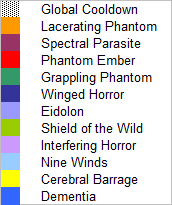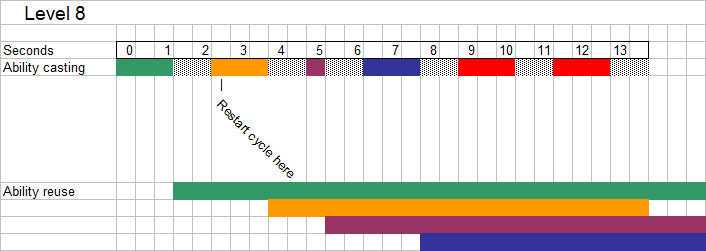
| Jason Richardson |
ELDRITCH CLASS ANALYSIS To better understand this analysis please first read the Eldritch Class Design Document. As mentioned elsewhere, this class design assumes that the pertaining MMORPG is similar in user interface and other gameplay elements to Blizzard Entertainment's "World of Warcraft". With no other player classes and no non-player enemies to balance against, this class was designed primarily to offer good utility and to play at a compelling rhythm with little inactivity in combat. The examples in this document are by no means intended to provide a comprehensive analysis of this class. Rather I have included this analysis only as a short demonstration of my thought processes in creating this design. COMBAT RHYTHM The "rhythms" I refer to in MMORPG combat are the patterns that a class's ability usage produces over time. During combat, periods of inactivity (caused by waiting on ability recharge timers) can cause a player to feel bored or helpless. Also being required to use a single ability, or a short cycle of abilities, excessively (aka ability spamming) removes variety in combat strategy, making combat feel monotonous. To ensure that the Eldritch class fosters an engaging combat rhythm, I have produced graphs of potential patterns in different combat scenarios to reveal how an intelligent player might manage optimal ability use. To ensure that the class remains interesting to play at low levels as well as higher levels, I will consider scenarios for the Eldritch at level 1, level 4, level 8, and level 20. Note that all scenarios assume a "global cooldown" of 1.0 seconds for all abilities. Global cooldown is the delay after completing the casting of any ability before the player is permitted to initiate another. Note also that these graphs only highlight the usage of offensive and key defensive combat abilities. The Eldritch does possess other utility abilities (such as Darken Vision, Augment Aggression, Amnesic Mist, etc.) the uses of which are situational and should not significantly impact this examination of combat rhythm. Level 1: initially the Eldritch possesses only a single direct damage attack, "Phantom Ember". There is no need for a graph of this scenario because at this level combat by necessity will consist of the Eldritch casting this single spell repeatedly until his target dies. While this may appear to run contrary to the good combat rhythm that I have just described, bear in mind that level 1 will pass very quickly and that beginning players will usually require simplicity to be able to learn how combat works. Please reference the following legend of colors to abilities for the graphs included in the remaining scenarios.
Level 4: by this level the Eldritch has gained two more combat abilities. For nearly any scenario at this level the optimally effective combat rhythm at this level would look something like the table below.
The colored bars in the first row represent the casting times for the Eldritch's abilities and assume no human delay between the global cooldown and the initiation of the next ability. The following rows display the reuse countdowns for the abilities used. In the case of Lacerating Phantom (orange), this countdown is the same as the ability's reuse time, 10.0 seconds, because it is possible that the ability will have been dispelled before its 15.0 second duration has completed and the Eldritch will want to be sure that its debuff is running at all times. For Spectral Parasite (purple), however, the countdown represents the ability's duration instead of its shorter reuse timer, because at this level Spectral Parasite should not be easily dispelled. This combat rhythm is still not ideal as it produces a cycle (the ability progression shown in the graph can be immediately repeated upon its completion) and Phantom Ember still needs to be repeated three times per cycle. Again this cannot be avoided at this level due to the small number of abilities that a level 4 Eldritch has at his disposal. Level 8: at this level the Eldritch has gained two new offensive combat abilities: Grappling Phantom and Winged Horror. A new combat rhythm would look something like this:
You can see that there is still a cycle that starts with the use of Lacerating Phantom (orange) because Grappling Phantom (green) has a long reuse time. Despite this cycle, combat rhythm is beginning to become more varied and Phantom Ember needs to be repeated only once per cycle. Level 20: skipping ahead, I will now examine two potential combat rhythms for a level 20 Eldritch. At this level the Eldritch's abilities are varied enough to provide different optimal combat rhythms for different scenarios. I will consider two such scenarios here: the Eldritch solo vs. a single computer-controlled, melee opponent and the Eldritch solo vs. a single computer-controlled, ranged, caster opponent. Because we do not know how much damage the Eldritch's spells are doing or how much damage his opponent can withstand I will consider only the first 30 seconds of what could be more prolonged fights. Eldritch vs. Melee: looking at the graph below, we can see that the cycles observed at levels 1-8 have ceased to exist. At level 20 the Eldritch's abilities are quite varied and combat rhythms can be ever-changing. Note that the reuse timers on the Eldritch's abilities are designed to prevent the player from having lulls in combat when he or she is required to wait for abilities to recharge.
The Eldritch shown above is using a trick. He cancels the channeling of Dementia and Cerebral Barrage after casting is complete. This is because the Eldritch cannot use any other abilities as long as he is channeling an ability and his channeled crowd control abilities cause no damage (the channeling components of these abilities are primarily intended for use in groups). However, both Dementia and Cerebral Barrage have a lingering effect on the target after channeling is cancelled; so when solo it can be effective to cast them, but to then cancel the channeling effect. If you study this graph you will also notice that, unlike the previous graphs, there are non-offensive abilities being used. We will cover the utility of these abilities in the section "Self Defense" below. Eldritch vs. Caster: as with the above Eldritch vs. Melee scenario, we can see that when fighting a ranged, spell-casting opponent, a level 20 Eldritch also has a wide variety of abilities at his disposal, and that again the cycles we observed at levels 1-8 no longer exist. Again note that the reuse timers on the Eldritch's abilities have been designed to prevent the player from having lulls in combat while he is required to wait for abilities to recharge.
SELF DEFENSE Being a defensive caster requires that the Eldritch be able to defend himself in solo situations or when he is acting as a group's tank. Let's observe again the two previously examined level 20 scenarios to see how the Eldritch is defending himself against melee and ranged attackers. In both scenarios the Eldritch opens by casting Eidolon, creating a mirror image of himself and masking his true location. The Eidolon will be the focus of the opponent's aggression unless it expires or is destroyed. Eldritch vs. Melee: the Eldritch class is intended to be more adept at defending itself from melee attacks than from ranged attacks. In this next graph we again see the level 20 solo Eldritch vs. a computer-controlled melee opponent.
This time I have added two new rows to the graph: "Out of melee range" and "Target Disabled". The former displays the times when the opponent is theoretically out of melee range, preventing melee attacks against the Eidolon. The latter displays the times during which the opponent is confused or stunned, again possibly preventing him from attacking the Eidolon (only possibly, because confused creatures may still attack random targets.) After the Eldritch's opponent has been alerted (aggroed in MMO speak), we can observe that it is either out of melee range or disabled for a total of 15 seconds out of the next 25.5 seconds of the fight (in other words, for almost 59% of the shown time after the opponent was aggroed). Note that the Eldritch casts Shield of the Wild upon his Eidolon as soon as the opponent is within melee range. This ability will augment the Eidolon's natural evasion by allowing it to survive a few hits. Ideally, the Eidolon will survive the time shown in this graph, distracting the opponent's attention away from the Eldritch. It is therefore theoretically possible that the Eldritch would receive no damage to himself/herself during the time shown. Also of note are the two offensive abilities with which the Eldritch opens combat: Grappling Phantom and Lacerating Phantom. Grappling Phantom provides a snaring effect, preventing the opponent from closing to the Eldritch at its normal speed. This is crucial in the Eldritch's attempt to keep the opponent out of melee range for as long as possible. Lacerating Phantom provides a significant debuff to the opponent's attack speed, decreasing the number of attacks that the Eidolon will have to evade. Both of these abilities create a pet that has a chance to draw the opponent's hostile attention. Though this may result in the destruction of the illusionary pet, it will serve to further protect the Eidolon. To be fair, lest we begin to suspect that the Eldritch is invulnerable to harm, beyond the time shown in this graph the Eldritch will become less capable of defending himself because the opponent will already be in melee range and the Eldritch's crowd control abilities will be on long recharge timers. It therefore behooves an Eldritch to choose opponents that he can dispatch quickly. Eldritch vs. Caster: when fighting a ranged opponent, the Eldritch no longer has the advantage of being protected while his opponent is out of melee range. Because of this, Nine Winds, the Eldritch's knock-back ability, is also not as useful against a ranged attacker (which is why that ability is not included in the following graph).
We can see that after the opponent has been aggroed, the Eldritch is only able to keep it disabled for 5 out of the remaining 24 seconds shown (about 21% of the time displayed in the graph.) It is therefore more likely in this scenario that the Eldritch's Eidolon will be destroyed (in which case the rhythm displayed here will probably be interrupted while the Eldritch creates another Eidolon). As with the previous melee scenario, we should take note of the Eldritch's opening offensive ability, Interfering Horror. It has the potential to draw the opponent's hostile attention onto an illusionary pet. More importantly, however, the pet has a chance to interrupt the opponent's ability casting, providing one of the Eldritch's primary defenses against spell-casting opponents.
|






